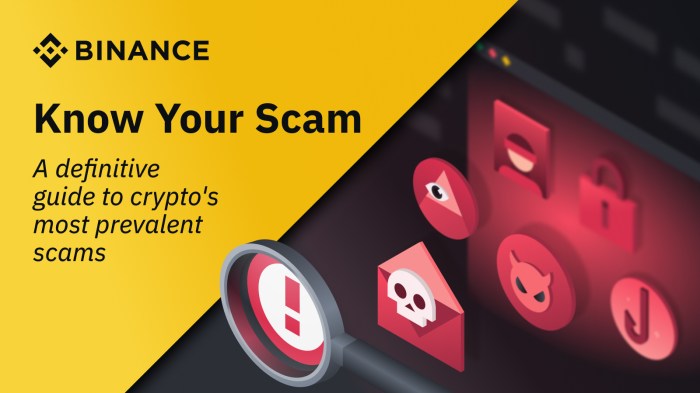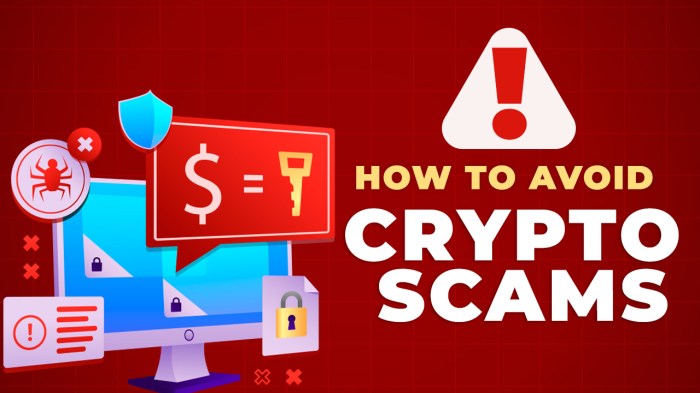How to Avoid Crypto Scams is crucial in today’s volatile digital landscape. The allure of quick riches in the cryptocurrency market attracts both legitimate investors and malicious actors. Understanding common scam tactics, recognizing red flags, and implementing robust security measures are paramount to protecting your digital assets. This guide provides practical strategies and insights to navigate the complexities of the crypto world safely and confidently.
From phishing emails designed to steal your private keys to sophisticated pump-and-dump schemes manipulating market prices, the threats are diverse and constantly evolving. We will explore the psychology behind these scams, examining how they exploit human vulnerabilities. Furthermore, we will delve into the importance of due diligence, the verification of platforms, and the role of education in mitigating risks. By understanding these elements, you can significantly reduce your vulnerability to crypto scams and build a more secure investment strategy.
Identifying Red Flags in Crypto Investments

Navigating the world of cryptocurrency investments requires vigilance. Numerous scams prey on unsuspecting individuals, promising unrealistic returns and ultimately leading to significant financial losses. Understanding the common red flags associated with these fraudulent schemes is crucial for protecting your assets. This section will detail these red flags, explore the psychological manipulation tactics employed by scammers, and provide a structured approach to evaluating potential investment opportunities.
Common Red Flags in Crypto Scams
Identifying fraudulent crypto investments requires a keen eye for detail. The following table Artikels common red flags, providing examples and suggesting mitigation strategies. Remember, if something seems too good to be true, it probably is.
| Type of Scam | Red Flag | Example | Mitigation Strategy |
|---|---|---|---|
| Pump and Dump Schemes | Sudden surge in price followed by a drastic drop; heavy social media promotion | A relatively unknown cryptocurrency experiences a massive price increase in a short period, driven by coordinated social media campaigns. The promoters then sell their holdings, causing the price to plummet, leaving late investors with significant losses. | Conduct thorough research before investing. Be wary of hype and social media endorsements. Analyze trading volume and price charts for unusual patterns. |
| Fake ICOs/IEOs | Unrealistic promises of high returns; lack of transparency about the team and project; poorly designed website; pressure to invest quickly | An ICO promises 1000% returns within a year with little to no information about the underlying technology or team. The website is poorly designed, and contact information is scarce. | Thoroughly research the project’s whitepaper. Verify the team’s credentials and experience. Look for independent reviews and audits. Avoid investing under pressure. |
| Phishing Scams | Suspicious emails or messages requesting login credentials or private keys; unexpected requests for personal information | An email claiming to be from a reputable exchange asks you to update your account details by clicking a link that leads to a fake website designed to steal your credentials. | Never click on links from unknown senders. Always verify the authenticity of emails and messages directly through the official channels of the relevant platform. |
| Ponzi Schemes | High returns with little or no risk; payments made to early investors from funds contributed by later investors | A cryptocurrency investment scheme promises guaranteed high returns with no risk, paying early investors using money from new investors. The scheme eventually collapses when there are not enough new investors. | Be wary of promises of guaranteed high returns with minimal or no risk. Research the investment thoroughly and verify its legitimacy with independent sources. |
| Rug Pulls | Developers suddenly disappear with investors’ funds; liquidity is removed from a decentralized exchange (DEX) | A new cryptocurrency project gains traction, and investors pour in their money. The developers then abruptly shut down the project and abscond with the funds. | Check the project’s code for vulnerabilities. Verify the team’s reputation and track record. Use reputable exchanges and avoid investing in newly launched projects without thorough due diligence. |
Psychological Manipulation in Crypto Scams
Crypto scams often exploit common psychological biases and emotions to manipulate investors. Fear of missing out (FOMO) is a powerful tool, pushing individuals to invest hastily without proper research. Greed, the desire for quick riches, fuels impulsive decisions, while confirmation bias leads investors to selectively seek information that supports their pre-existing beliefs, ignoring red flags. Scammers also leverage social proof, using testimonials and endorsements to create a false sense of legitimacy. Understanding these psychological mechanisms is essential in resisting manipulative tactics.
Decision-Making Flowchart for Identifying Fraudulent Crypto Investments
The following flowchart illustrates a structured approach to evaluating potential crypto investment opportunities:
[Imagine a flowchart here. The flowchart would start with a box labeled “Crypto Investment Opportunity.” This would branch to two boxes: “Does it seem too good to be true?” Yes leads to “High likelihood of scam, proceed with extreme caution or avoid.” No leads to “Thorough Due Diligence.” Thorough Due Diligence would branch to “Is the project transparent and verifiable?” Yes leads to “Proceed with caution, continue research.” No leads to “High likelihood of scam, proceed with extreme caution or avoid.” “Proceed with caution, continue research” leads to “Are there any red flags present?” Yes leads to “High likelihood of scam, proceed with extreme caution or avoid.” No leads to “Consider investment, but proceed with caution.” ]
Understanding Common Crypto Scam Tactics
Navigating the world of cryptocurrency requires a keen awareness of prevalent scam tactics. Understanding these methods is crucial for protecting your investments and avoiding significant financial losses. This section will detail common approaches used by scammers, providing you with the knowledge to identify and avoid them.
Phishing Scams Targeting Cryptocurrency Users
Phishing scams leverage the trust and eagerness of cryptocurrency users. Scammers often employ sophisticated techniques to impersonate legitimate exchanges, projects, or individuals. In email phishing, deceptive messages may appear to originate from a reputable source, urging users to click on malicious links leading to fake login pages designed to steal login credentials and private keys. Social media phishing often involves creating fake profiles mimicking influential figures in the crypto space. These fake profiles might promote fraudulent investment opportunities or request personal information under false pretenses. For example, a scammer might create a Twitter account mirroring a well-known crypto influencer, then tweet about a “limited-time” investment opportunity, linking to a malicious website. Victims who fall for these scams often lose their cryptocurrency holdings.
Pump-and-Dump Schemes
Pump-and-dump schemes involve artificially inflating the price of a cryptocurrency through coordinated buying (the “pump”), followed by a quick sell-off by the perpetrators (the “dump”), leaving unsuspecting investors with worthless assets. These schemes often rely on social media manipulation and coordinated efforts to create a false sense of demand. For instance, a group of scammers might simultaneously promote a little-known cryptocurrency on various online forums and social media platforms, creating a buzz and driving up the price. Once the price reaches a certain point, the scammers sell their holdings, causing the price to plummet, leaving investors with significant losses. Identifying these schemes requires careful scrutiny of trading volume, price fluctuations, and the overall legitimacy of the promoted cryptocurrency.
Comparison of Legitimate and Fraudulent Crypto Projects
| Factor | Legitimate Crypto Project | Fraudulent Crypto Project |
|---|---|---|
| Team Transparency | Clearly identified team members with verifiable backgrounds and experience. Publicly available contact information. | Anonymous or pseudonymous team members with unclear backgrounds. Lack of contact information or unresponsive communication. |
| Whitepaper Quality | Detailed and well-written whitepaper outlining the project’s goals, technology, and roadmap. Free from grammatical errors and inconsistencies. | Poorly written or incomplete whitepaper with vague or unrealistic promises. May contain technical inaccuracies or inconsistencies. |
| Community Engagement | Active and engaged community with open communication channels. Regular updates and responses to community questions. | Limited or nonexistent community engagement. Lack of transparency and responsiveness to community concerns. |
| Audits and Security | Regular security audits conducted by reputable firms. Transparent reporting of any security vulnerabilities. | Lack of security audits or vague claims about security measures. May have a history of security breaches or exploits. |
| Tokenomics | Clearly defined token distribution and allocation. Realistic token utility and use cases. | Unclear or unrealistic token distribution. Lack of clear utility or use cases for the token. |
Safeguarding Your Crypto Assets
Protecting your cryptocurrency investments requires a multi-layered approach encompassing secure storage, robust passwords, and proactive reporting mechanisms. Neglecting these precautions significantly increases your vulnerability to scams and theft. This section details best practices to minimize your risk.
The foundation of secure crypto asset management lies in understanding and implementing proper wallet security and account protection. This involves choosing the right type of wallet, utilizing strong passwords, and employing multi-factor authentication wherever possible. Equally crucial is knowing how to report any suspicious activity or suspected scams to the appropriate channels.
Understanding how to avoid crypto scams is crucial before engaging in any digital asset activity. This includes verifying project legitimacy and only using reputable exchanges. However, the positive side of crypto is also significant; learn more about responsible investing by exploring the ethical aspects of crypto in Crypto Philanthropy: Giving Back with Blockchain , which helps you understand the potential for good within this technology.
Ultimately, responsible participation and thorough research remain your best defenses against scams.
Cryptocurrency Wallet Security
Selecting the right cryptocurrency wallet is paramount. Hardware wallets, software wallets, and even exchange wallets each offer varying levels of security. Understanding these differences is key to making an informed decision based on your risk tolerance and the amount of cryptocurrency you hold.
Protecting yourself from crypto scams requires vigilance. Understanding market dynamics is crucial; for instance, learning how investor behavior impacts prices is key, as explained in this insightful article: How Market Sentiment Affects Crypto Prices. This knowledge helps you identify potentially manipulated markets, a common tactic in many crypto scams, enabling you to make more informed and safer investment decisions.
- Hardware Wallets: These physical devices store your private keys offline, offering the highest level of security against online threats like hacking and phishing. They typically resemble USB drives and require a PIN for access. Examples include Ledger and Trezor.
- Software Wallets: These wallets are applications installed on your computer or mobile device. While convenient, they are more vulnerable to malware and hacking if your device is compromised. Examples include Exodus and Electrum. It’s crucial to ensure you download them from official sources only.
- Exchange Wallets: These wallets are provided by cryptocurrency exchanges where you buy and sell crypto. While convenient for trading, they are generally considered less secure than hardware or software wallets because your private keys are held by the exchange. This exposes you to risks associated with the exchange’s security practices.
Password Management and Two-Factor Authentication (2FA)
Strong, unique passwords and 2FA are indispensable for protecting your crypto accounts. Weak or reused passwords leave you vulnerable to brute-force attacks and credential stuffing. 2FA adds an extra layer of security, requiring a second verification method (like a code sent to your phone) in addition to your password.
- Password Strength: Use long, complex passwords that combine uppercase and lowercase letters, numbers, and symbols. Password managers can help generate and securely store these passwords.
- Uniqueness: Never reuse the same password across multiple accounts. If one account is compromised, attackers could gain access to others using the same password.
- Two-Factor Authentication (2FA): Enable 2FA on all your crypto exchanges and wallet accounts. This significantly reduces the risk of unauthorized access, even if your password is stolen.
Reporting Crypto Scams
If you believe you’ve been a victim of a crypto scam, reporting it promptly is crucial. This helps law enforcement investigate the scam and potentially recover your funds. Reporting also helps protect others from falling victim to the same scam.
Protecting yourself from cryptocurrency scams requires vigilance. A key aspect is understanding the space, and learning from the experiences of others, including the valuable insights shared by women making significant contributions to the crypto world; you can find more information on this at Women in Cryptocurrency. Ultimately, thorough research and cautious investment strategies are your best defenses against fraudulent schemes.
- Gather Evidence: Collect all relevant information, including transaction details, communication records (emails, messages), and any websites or addresses involved in the scam.
- Report to Law Enforcement: File a report with your local law enforcement agency and the FBI’s Internet Crime Complaint Center (IC3).
- Report to the Exchange or Platform: If the scam involved a specific cryptocurrency exchange or platform, report it to their customer support team. Provide them with all the evidence you’ve gathered.
- Monitor Your Accounts: Closely monitor your crypto accounts for any further suspicious activity.
Due Diligence and Research in Crypto Investments
Thorough due diligence is paramount before investing in any cryptocurrency project. The volatile nature of the crypto market necessitates a cautious approach, ensuring your investment aligns with your risk tolerance and is backed by sound research. Failing to conduct proper due diligence can lead to significant financial losses. This section Artikels crucial steps to protect your investment.
Investing in cryptocurrencies requires more than just following hype; it demands a critical evaluation of the underlying project. Independent research and community analysis are essential to verify the legitimacy and potential of a cryptocurrency. By understanding the project’s whitepaper, team, technology, and market position, you can make informed decisions and mitigate potential risks associated with scams or failing projects.
A Checklist for Thorough Due Diligence
Before investing, consider this checklist of critical steps:
- Examine the Whitepaper: Carefully review the project’s whitepaper. Look for clear explanations of the project’s goals, technology, tokenomics, and team. Be wary of vague or overly technical language that obscures the project’s true nature. A well-written whitepaper will clearly articulate the problem the project solves, its proposed solution, and its market viability.
- Investigate the Team: Research the project’s team members. Look for their experience, background, and previous projects. Verify their identities through LinkedIn or other professional platforms. A transparent and experienced team significantly reduces the risk of a scam.
- Analyze the Technology: Understand the underlying technology of the cryptocurrency. Is it innovative? Is it secure? Is the code open-source and auditable? Assess the technology’s scalability and potential for long-term growth. Look for independent audits of the codebase, which can provide valuable insights into security vulnerabilities.
- Assess the Tokenomics: Analyze the project’s tokenomics. How many tokens are in circulation? What is the token distribution? What is the token’s utility? Understanding the token’s economic model is crucial for assessing its long-term value and potential for appreciation.
- Review Community Engagement: Evaluate the project’s community engagement. Is there an active and engaged community? What is the overall sentiment towards the project? A strong and supportive community can indicate a healthy and sustainable project.
- Scrutinize the Roadmap: Review the project’s roadmap. Is it realistic? Are the milestones achievable? A well-defined roadmap with clear milestones and deadlines shows a commitment to delivering on promises.
Verifying Crypto Project Legitimacy
Independent research and community reviews are crucial in verifying the legitimacy of crypto projects. Many resources are available to help you assess a project’s credibility and potential.
Resources for Verifying Crypto Project Authenticity
| Resource | Description | Strengths | Weaknesses |
|---|---|---|---|
| Blockchain Explorers (e.g., Etherscan, BscScan) | Tools that allow you to view transaction history, token balances, and other on-chain data. | Provides verifiable on-chain data, confirming token existence and transactions. | Doesn’t provide information about the project’s team, technology, or roadmap. |
| Social Media Analysis (e.g., Twitter, Telegram) | Analyzing community sentiment, engagement, and discussions surrounding the project. | Provides insights into community perception and project activity. | Can be easily manipulated or contain biased information. |
| News Articles and Reviews (e.g., CoinDesk, Cointelegraph) | Reading reputable news articles and reviews about the project. | Offers a broader perspective on the project, including analysis from experts. | Can be subjective and potentially biased. |
| Independent Audits | Reviews of the project’s smart contracts by security firms. | Identifies potential vulnerabilities in the code. | Not all projects undergo independent audits. |
Recognizing and Avoiding Fake Crypto Exchanges and Platforms
The cryptocurrency market’s rapid growth has unfortunately attracted numerous fraudulent actors. One significant risk for investors is interacting with fake crypto exchanges and platforms designed to steal funds. Understanding how to distinguish legitimate exchanges from fraudulent ones is crucial for protecting your investments. This section will Artikel key characteristics to look for and provide guidance on verifying the legitimacy of a platform before entrusting it with your cryptocurrency.
The proliferation of fake crypto exchanges stems from the relative ease of creating a visually appealing website and the lack of immediate oversight in some jurisdictions. These platforms often mimic the appearance of established exchanges, employing sophisticated techniques to deceive unsuspecting users. The consequences of using such platforms can range from the loss of funds to identity theft and exposure to further scams.
Key Differences Between Legitimate and Fraudulent Crypto Exchanges
Legitimate exchanges prioritize security, adhere to regulatory standards where applicable, and offer robust customer support. Conversely, fraudulent exchanges often lack these essential features. Security measures on legitimate exchanges typically include two-factor authentication (2FA), robust encryption protocols, and regular security audits. Regulatory compliance involves adhering to anti-money laundering (AML) and know-your-customer (KYC) regulations, demonstrating transparency and accountability. Legitimate exchanges also provide readily available and responsive customer support channels.
Examples of Fake Crypto Exchanges and Their Deceptive Tactics
While naming specific defunct fraudulent exchanges could inadvertently promote them, the tactics employed are consistently similar. Fake exchanges often use deceptive marketing promising unrealistically high returns or employing celebrity endorsements without verification. Their websites might mimic the design and functionality of reputable exchanges, creating a false sense of security. They may also use sophisticated phishing techniques to steal user credentials and private keys. Users interacting with these platforms often experience the complete loss of their deposited funds, with little to no recourse. For instance, a fake exchange might advertise incredibly high interest rates on staked cryptocurrencies, far exceeding market averages, to attract investors. Once users deposit their funds, the platform disappears, leaving investors with no way to recover their assets.
Verifying the Legitimacy of a Crypto Exchange
Before depositing any funds, thorough due diligence is essential. This includes examining the exchange’s website security, checking for legal documentation and licenses, and reviewing user feedback.
Website security should be a top priority. Look for a secure HTTPS connection (indicated by a padlock icon in the address bar) and examine the website’s design for inconsistencies or unprofessional aspects. A professional, well-maintained website with clear information is a positive sign. Conversely, poor grammar, broken links, and a lack of contact information are red flags.
Legal documentation and licensing should be readily available and easily accessible. Legitimate exchanges typically display information about their registration, licenses, and compliance with relevant regulations. This transparency demonstrates their commitment to operating legally and ethically.
User reviews and feedback provide valuable insights into an exchange’s reputation and reliability. Check independent review sites and forums for user experiences. Look for consistent patterns of positive or negative feedback. A high volume of negative reviews, particularly those related to security breaches or difficulties withdrawing funds, should raise serious concerns.
The Role of Education and Community Awareness

The cryptocurrency landscape is constantly evolving, making continuous learning crucial for navigating its complexities and avoiding scams. A well-informed investor is far less susceptible to fraudulent schemes. Staying updated on the latest scams, security protocols, and regulatory changes is paramount to protecting your digital assets. This involves actively seeking reliable information and critically evaluating sources before making any investment decisions.
The importance of community engagement cannot be overstated. Participating in reputable online forums and communities allows you to learn from experienced investors, share insights, and receive warnings about emerging scams. However, it’s crucial to approach all online information with a discerning eye, understanding that not all advice is created equal.
Reputable Resources for Crypto Security Education
Access to reliable information is the cornerstone of effective crypto security. Several resources offer comprehensive educational materials, covering topics ranging from basic blockchain technology to advanced security practices. These resources provide a crucial counterbalance to the often misleading information circulating online.
- Websites: Many reputable cryptocurrency exchanges and blockchain companies offer educational resources on their websites, including articles, tutorials, and FAQs on security best practices. For example, Coinbase’s learning center provides a wide range of educational content, while Binance Academy offers in-depth courses on various cryptocurrency topics.
- Forums: Participating in established and moderated cryptocurrency forums can provide valuable insights and warnings from experienced users. However, always approach information critically and verify claims from multiple sources before acting on them. Remember to avoid forums known for promoting scams or misinformation.
- Educational Materials: Numerous online courses and educational platforms offer in-depth training on cryptocurrency security. These resources often cover advanced topics such as private key management, hardware wallets, and identifying phishing attempts. Look for courses from reputable institutions or individuals with a proven track record in the field.
Identifying and Avoiding Misinformation
The internet, particularly social media, is rife with misinformation regarding cryptocurrencies. Pump-and-dump schemes, fake celebrity endorsements, and promises of unrealistic returns are common tactics used to lure unsuspecting investors. Therefore, developing a critical mindset is essential to avoid falling victim to these scams.
- Verify Information: Always cross-reference information from multiple reputable sources before making any investment decisions. A claim made on a single social media post should never be taken at face value.
- Be Skeptical of Guarantees: No legitimate investment guarantees unrealistic returns. Promises of quick riches or guaranteed profits are major red flags indicative of a scam.
- Beware of High-Pressure Tactics: Legitimate investment opportunities rarely involve high-pressure sales tactics or demands for immediate action. If you feel pressured to invest quickly, it’s a strong indication of a scam.
- Check for Official Sources: If a cryptocurrency project claims to be endorsed by a celebrity or company, verify this claim on the official website or social media accounts of the supposed endorser.
Protecting Yourself from Social Engineering Tactics: How To Avoid Crypto Scams
Social engineering is a manipulative technique used by scammers to trick individuals into revealing sensitive information or performing actions that compromise their security. In the cryptocurrency world, this often involves gaining access to wallets, private keys, or investment funds. Understanding common social engineering tactics and developing strong defenses is crucial to safeguarding your crypto assets.
Social engineering tactics in crypto scams often leverage the excitement and potential for high returns associated with the industry. Scammers exploit human psychology, preying on greed, fear, or a desire for quick profits. This section will detail several common tactics and provide strategies for effective protection.
Impersonation and Baiting Tactics
Impersonation involves scammers posing as legitimate entities, such as cryptocurrency exchanges, developers, or even well-known figures in the crypto community. They may contact victims through various channels, such as email, social media, or even phone calls, using fabricated identities to build trust and gain access to information. Baiting, on the other hand, involves offering enticing incentives, such as free cryptocurrency, exclusive investment opportunities, or early access to a new project, to lure victims into a trap. These seemingly lucrative offers often lead to malicious websites or phishing attempts. For example, a scammer might impersonate a popular crypto influencer on Twitter, promising exclusive access to a new coin launch in exchange for a small investment or private key information.
Pretexting and Strategies for Protection
Pretexting involves creating a believable scenario or excuse to gain the victim’s trust and obtain sensitive information. Scammers may claim to be from customer support, needing to verify account details due to a security breach or a suspicious transaction. They might also use urgency to pressure victims into acting quickly without thinking critically. Protecting yourself from these tactics requires a proactive approach focusing on critical thinking and skepticism. Never share your private keys or seed phrases with anyone, regardless of how legitimate the request may seem. Always verify the identity of anyone requesting sensitive information through official channels, such as the official website or support contact information of the organization in question. Regularly review your account activity for unauthorized transactions and immediately report any suspicious activity.
Scenario-Based Exercise: Identifying and Responding to Social Engineering Attempts
Imagine you receive an email seemingly from your cryptocurrency exchange, stating that your account has been compromised and requires immediate verification. The email includes a link to a website that looks identical to your exchange’s official site. This is a classic pretexting and impersonation attempt. A proper response would involve: 1) Never clicking on links in unsolicited emails. 2) Independently accessing your exchange account through your saved bookmarks or a trusted search engine. 3) Checking your exchange’s official website or contacting their customer support directly through verified channels for confirmation of any security issues. If you find discrepancies between the email and the information on the official website, immediately report the phishing attempt to the exchange and any relevant authorities. Do not engage with the scammer or provide any personal information.
Understanding Smart Contracts and Their Risks
Smart contracts, self-executing contracts with the terms of the agreement between buyer and seller being directly written into lines of code, offer automation and transparency in the blockchain world. However, their inherent reliance on code introduces significant security risks that can lead to substantial financial losses or even the complete compromise of a project. Understanding these risks is crucial for anyone interacting with decentralized applications (dApps) or investing in projects utilizing smart contracts.
Smart contracts are vulnerable to various security flaws, many stemming from coding errors or vulnerabilities in the underlying blockchain platform. These vulnerabilities can be exploited by malicious actors to drain funds, manipulate data, or disrupt the intended functionality of the contract. The consequences can range from minor inconveniences to catastrophic financial losses for users and project stakeholders.
Common Smart Contract Vulnerabilities
Several common vulnerabilities frequently plague smart contracts. These include reentrancy attacks, where a malicious contract calls back into the original contract before the first call completes, potentially allowing the attacker to drain funds repeatedly. Another prevalent issue is arithmetic overflow/underflow, which occurs when mathematical operations result in values exceeding the maximum or falling below the minimum representable value, leading to unexpected behavior and potential exploits. Additionally, denial-of-service (DoS) attacks can render a smart contract unusable by overwhelming it with requests, preventing legitimate users from accessing its functionality. Finally, logic errors in the contract’s code can lead to unintended consequences, including unintended access to funds or data.
Smart Contract Auditing and Review Best Practices
Before interacting with any smart contract, thorough auditing and review are paramount. This involves a systematic examination of the contract’s code to identify potential vulnerabilities and ensure its functionality aligns with the intended purpose. A comprehensive audit typically includes a manual code review by experienced security professionals and the use of automated security analysis tools. The results of these audits should be publicly available and transparent to build trust and confidence among users.
Methods for Analyzing Smart Contract Security
Several methods exist for analyzing the security of smart contracts. Manual code review involves a meticulous line-by-line inspection of the code by security experts, who identify potential weaknesses and vulnerabilities based on their knowledge and experience. This approach is highly effective but can be time-consuming and expensive. Automated tools, on the other hand, use static and dynamic analysis techniques to automatically scan the code for known vulnerabilities and potential issues. These tools can significantly speed up the process but might not catch all vulnerabilities, especially those requiring deeper contextual understanding. Ideally, a combination of manual review and automated tools provides the most comprehensive security assessment. For instance, a tool might flag potential vulnerabilities, which a human expert can then investigate in more detail to determine their severity and potential impact. This combined approach provides a more robust and reliable security analysis than either method alone.
Legal and Regulatory Aspects of Crypto Scams
The rapidly evolving nature of cryptocurrency presents unique challenges for law enforcement and regulators worldwide. Understanding the legal frameworks governing crypto scams is crucial for both investors and authorities aiming to protect individuals and maintain market integrity. This section will explore the legal landscape surrounding cryptocurrency scams, focusing on reporting mechanisms and individual rights.
The legal treatment of cryptocurrency scams varies significantly across jurisdictions. Some countries have established specific laws addressing digital asset fraud, while others rely on existing legislation related to securities fraud, wire fraud, or money laundering. The lack of a universally harmonized legal framework often complicates cross-border investigations and prosecutions. Furthermore, the decentralized and pseudonymous nature of cryptocurrencies makes tracing illicit funds and identifying perpetrators challenging.
Reporting Crypto Scams to Authorities
Reporting a cryptocurrency scam is the first crucial step in mitigating losses and potentially assisting in the prosecution of perpetrators. Victims should gather all relevant information, including transaction details, communication records with scammers, and any platform or exchange used in the scam. Depending on the jurisdiction, reports can be filed with various agencies. In the United States, for example, the Federal Bureau of Investigation (FBI), the Securities and Exchange Commission (SEC), and the Commodity Futures Trading Commission (CFTC) may be involved depending on the nature of the scam. Other countries have equivalent agencies dedicated to financial crimes or cybercrime. It’s important to research the relevant agencies in your specific jurisdiction to ensure your report reaches the appropriate authorities.
Understanding Legal Rights and Responsibilities, How to Avoid Crypto Scams
As a cryptocurrency investor, understanding your legal rights and responsibilities is paramount. While the legal landscape is constantly evolving, it’s crucial to be aware of consumer protection laws that may apply to your investments. These laws may offer some recourse in cases of fraud or misrepresentation. It’s equally important to understand your responsibilities as an investor, including conducting thorough due diligence before investing and being mindful of regulatory requirements. Failing to exercise due diligence could limit your legal options if you become a victim of a scam. Consulting with legal professionals specializing in cryptocurrency and financial law is advisable to gain a comprehensive understanding of your rights and obligations within your specific jurisdiction.
Jurisdictional Differences in Crypto Scam Regulations
The regulatory landscape surrounding cryptocurrencies varies widely. Some countries have embraced a more proactive approach, establishing comprehensive regulatory frameworks specifically for digital assets. Others maintain a more cautious stance, opting to regulate cryptocurrencies through existing financial crime laws. This lack of global uniformity creates challenges for both investors and law enforcement agencies. For example, a scam originating in one country might utilize exchanges or wallets based in another, making international cooperation crucial for effective investigations and asset recovery. The legal complexities involved in cross-border investigations highlight the need for increased international collaboration and the harmonization of regulatory frameworks.
Last Word

Navigating the cryptocurrency market requires vigilance and a proactive approach to security. By diligently following the guidelines Artikeld in this guide – from recognizing red flags and employing robust security practices to conducting thorough due diligence and staying informed about emerging threats – you can significantly reduce your risk of becoming a victim of a crypto scam. Remember, continuous learning and a healthy dose of skepticism are your best defenses in this dynamic and ever-evolving landscape. Protecting your investments requires ongoing effort, but the rewards of securing your digital assets are well worth the investment of time and attention.





